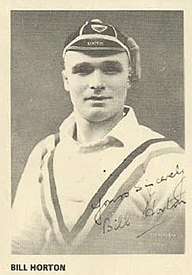Bill Horton (rugby league)
William "Bill" Horton (17 February 1905 – 19 January 1992) was an English professional rugby league footballer who played in the 1920s and 1930s. He played at representative level for Great Britain, England and Yorkshire, and at club level for Wakefield Trinity (Heritage № 307) (captain), as a second-row, or loose forward, i.e. number 11 or 12, or 13, during the era of contested scrums.[2]
 | |||||||||||||||||||||||||||||||||||||||||||||||||||||||||
Personal information | |||||||||||||||||||||||||||||||||||||||||||||||||||||||||
|---|---|---|---|---|---|---|---|---|---|---|---|---|---|---|---|---|---|---|---|---|---|---|---|---|---|---|---|---|---|---|---|---|---|---|---|---|---|---|---|---|---|---|---|---|---|---|---|---|---|---|---|---|---|---|---|---|---|
| Full name | William Horton | ||||||||||||||||||||||||||||||||||||||||||||||||||||||||
| Born | 17 February 1905 Knottingley,[1] Wakefield, England | ||||||||||||||||||||||||||||||||||||||||||||||||||||||||
| Died | 19 January 1992 (aged 86) | ||||||||||||||||||||||||||||||||||||||||||||||||||||||||
Playing information | |||||||||||||||||||||||||||||||||||||||||||||||||||||||||
| Height | 5 ft 11 in (1.80 m) | ||||||||||||||||||||||||||||||||||||||||||||||||||||||||
| Weight | 13 st 9 lb (87 kg) | ||||||||||||||||||||||||||||||||||||||||||||||||||||||||
| Position | Second-row, Loose forward | ||||||||||||||||||||||||||||||||||||||||||||||||||||||||
| |||||||||||||||||||||||||||||||||||||||||||||||||||||||||
Background
Bill Horton was born in Knottingley, Wakefield, West Riding of Yorkshire, England, and he died aged 86.
Playing career
International honours
Bill Horton won caps for England while at Wakefield Trinity in 1928 against Wales, in 1929 against Other Nationalities, in 1932 against Wales, in 1933 against Australia, in 1936 against Wales,[3] and won caps for Great Britain while at Wakefield Trinity in 1928 against Australia (3 matches), New Zealand (3 matches), in 1929-30 against Australia, in 1932 against Australia (3 matches), New Zealand, and in 1933 against Australia (3 matches).[4]
County Cup Final appearances
Bill Horton played right-second-row, i.e. number 12, in Wakefield Trinity's 9-8 victory over Batley in the 1924–25 Yorkshire County Cup Final during the 1924–25 season at Headingley Rugby Stadium, Leeds on Saturday 22 November 1924, played right-second-row in the 3-10 defeat by Huddersfield in the 1926–27 Yorkshire County Cup Final during the 1926–27 season at Headingley Rugby Stadium, Leeds on Wednesday 1 December 1926, played left-second-row, i.e. number 11, in the 0-8 defeat by Leeds in the 1932–33 Yorkshire County Cup Final during the 1932–33 season at Fartown Ground, Huddersfield on Saturday 19 November 1932, played left-second-row in the 5-5 draw with Leeds in the 1934–35 Yorkshire County Cup Final during the 1934–35 season at Crown Flatt, Dewsbury on Saturday 27 October 1934, played left-second-row in the 2-2 draw with Leeds in the 1934–35 Yorkshire County Cup Final replay during the 1934–35 season at Fartown Ground, Huddersfield on Wednesday 31 October 1934, played left-second-row in the 0-13 defeat by Leeds in the 1934–35 Yorkshire County Cup Final second replay during the 1934–35 season at Parkside, Hunslet on Wednesday 7 November 1934, and played left-second-row in the 2-9 defeat by York in the 1936–37 Yorkshire County Cup Final during the 1936–37 season at Headingley Rugby Stadium, Leeds on Saturday 17 October 1936.
Notable tour matches
Bill Horton played left-second-row, i.e. number 11, in Wakefield Trinity's 6-17 defeat by Australia in the 1933–34 Kangaroo tour of Great Britain match during the 1933–34 season at Belle Vue, Wakefield on Saturday 28 October 1933.
Club career
Bill Horton made his début for Wakefield Trinity during August 1924, he played his last match for Wakefield Trinity during the 1937–38 season, and he appears to have scored no drop-goals (or field-goals as they are currently known in Australasia), but prior to the 1974–75 season all goals, whether; conversions, penalties, or drop-goals, scored 2-points, consequently prior to this date drop-goals were often not explicitly documented, therefore '0' drop-goals may indicate drop-goals not recorded, rather than no drop-goals scored. In addition, prior to the 1949–50 season, the archaic field-goal was also still a valid means of scoring points.
Genealogical information
Bill Horton married Sybil Irene (née Webber) (birth registered during second ¼ 1903 in Bristol district – death unknown) during June 1927 in Wakefield.[5] They had children; John A. Horton (birth registered during first ¼ 1928 in Wakefield district).
References
- "The Leeds Loiner - Challenge Cup semi-final - Keighley v. Wakefield Trinity, Saturday 3 April 1937". footballzone.co.uk. 31 December 2016. Archived from the original on 28 March 2017. Retrieved 1 January 2017.
- "Statistics at rugbyleagueproject.org". rugbyleagueproject.org. 31 December 2017. Retrieved 1 January 2018.
- "England Statistics at englandrl.co.uk". englandrl.co.uk. 31 December 2017. Archived from the original on 18 April 2018. Retrieved 1 January 2018.
- "Great Britain Statistics at englandrl.co.uk". englandrl.co.uk. 31 December 2017. Archived from the original on 18 April 2018. Retrieved 1 January 2018.
- "Family Tree at ancestry.com". rootsweb.ancestry.com. 31 December 2011. Retrieved 1 January 2012.
- Lindley, John (1960). Dreadnoughts - A HISTORY OF Wakefield Trinity F. C. 1873 - 1960. John Lindley Son & Co Ltd. ISBN n/a
External links
- Knottingley In 1968 - 25 July 1968 - Aire Street History
- RootsWeb > Archiver > WEST-RIDING > 1999-03 > 0920940220
- RootsWeb > Archiver > WEST-RIDING > 1999-03 > 0922827299
- RootsWeb > Archiver > KILBURN-UK > 2002-01 > 1010751181
- (archived by web.archive.org) Green & Gold makes its début